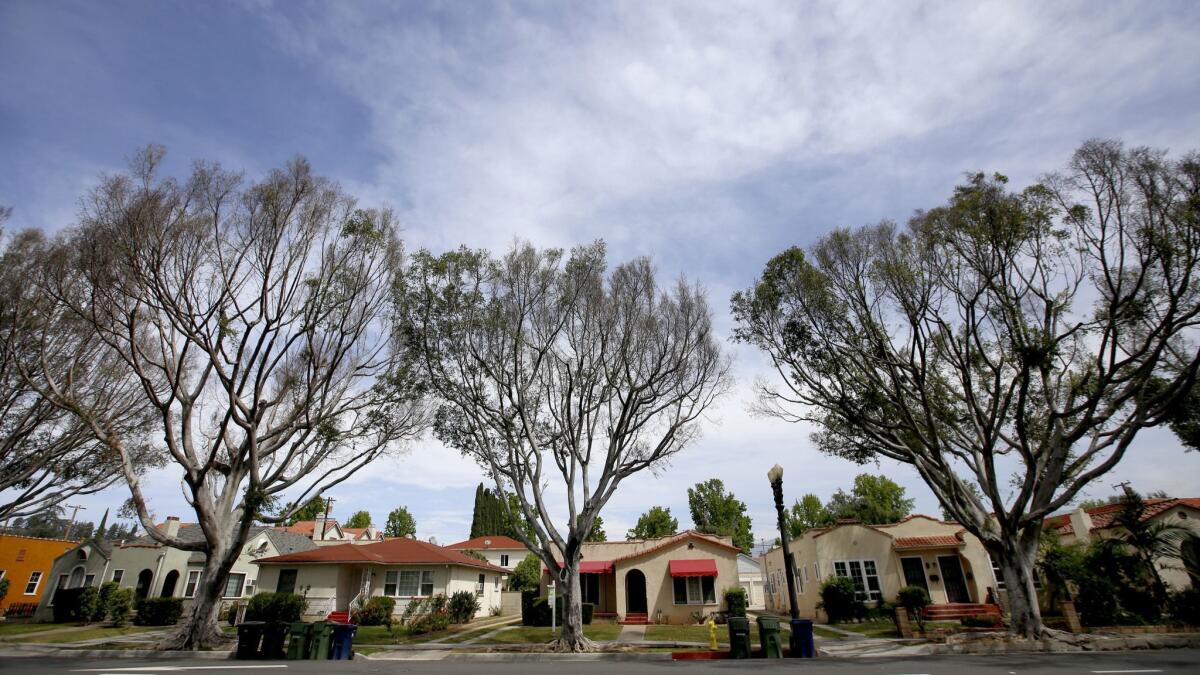Editorial: California’s extreme housing crisis calls for extreme measures. That includes SB 50

- Share via
By now it should surprise no one to hear that California is in the midst of an extraordinary housing crisis.
For years, rents have increased far faster than incomes, so that more working people are being driven out of their homes. Some are moving away from cities, farther from their jobs, while others have been priced out of the state altogether. Some are living in cars, RVs, on the couches of friends and families, or on the streets. Gentrification and displacement are taking formerly affordable rental units off the market, and restrictive zoning rules along with high building costs and anti-development sentiment have made it increasingly difficult to create new affordable housing. California needs to build 180,000 units of housing each year just to keep up with demand, but it has has averaged only 80,000 a year over the last decade. Even workers with jobs that pay well are finding that the dream of buying a home is out of reach.
For much of its history, California has been seen as a land of opportunity. But the decades-long failure to build enough housing has left the state anything but inclusive. The lack of housing affordability undermines the state’s prosperity, its quality of life and its future.
Though much of land-use policy is handled by local governments, state lawmakers have stepped in during the last few years and passed a slew of bills designed to make home building easier, including laws that streamline the construction of backyard “in-law” units and make it harder for cities to reject new development. Gov. Gavin Newsom has set a target of building 3.5 million new homes by 2025.
The most ambitious and audacious proposal yet is currently making its way through the Legislature. Written by Sen. Scott Wiener (D-San Francisco), Senate Bill 50 would override local zoning laws to require cities and counties to allow mid-rise apartment buildings within half a mile of major transit stops or in “jobs-rich” areas. It would do away with single-family zoning altogether, allowing property owners to convert single-family houses anywhere in the state into four-unit apartment houses.
SB 50 recognizes that we’ve been trying to preserve single-family neighborhoods in amber. That cannot continue.
SB 50 is bold, to be sure; it would herald a dramatic, but ultimately necessary transition toward greater density in California. We would like to see it passed — if it is first amended to give cities a final chance to take the lead in building the necessary housing, and if it gives a pass to those cities that are already succeeding. If cities prove unable or unwilling to take the necessary steps, then the state should step in.
Certainly, local governments have played a significant role in creating the housing crisis. Far too often across the state — including in Los Angeles — neighborhood NIMBYs and the elected officials who represent them have blocked new housing construction, often in the name of protecting neighborhood character. Apartments and condos are banned in nearly 80% of the state’s residential neighborhoods, which are zoned exclusively for single-family houses. Closing those areas to multi-family development dramatically limits the number of units that can be built.
There’s a lot of angst about the threat SB 50 poses to the look and feel of existing communities. But the fact is that cities must grow and change, as they always have. A place like Los Angeles can’t remain a city of cars and freeways and single-family homes forever. If the state is going to build 3.5 million homes without paving every inch of farmland and open space, then cities have to allow denser, taller construction. It makes sense to concentrate that development near mass transit and jobs, so people can get around without driving, which would ease traffic congestion and cut the vehicle emissions that are polluting the air and fueling global climate change.
But a one-size-fits-all, statewide approach to the problem should be a last resort. In general, it is preferable to have the state set housing targets while letting cities figure out how to meet those targets. Why? Because local governments are closest to the people most affected by the land-use decisions and can create development policies that address the unique needs of communities. For example, in South L.A., residents helped develop land-use plans that would incentivize affordable housing, grocery stores and sit-down restaurants.
For years, too many cities have ignored state housing mandates because there were no consequences for doing so. Now they should be given one last chance to meet their goals, knowing that if they continue to delay their land-use authority will be preempted by the state. If within a set period of time — say, two years — a municipality is not on the road to building a sufficient amount of new housing, then SB 50’s tough new zoning rules should kick in.
Enter the Fray: First takes on the news of the minute »
Another big issue still on the table with SB 50 has to do with renters and affordable housing. Tenant’s rights advocates were instrumental in killing Wiener’s bill last year because they feared it would encourage luxury development and lead to the displacement of low-income tenants. Wiener added significant tenant protections to this year’s bill, but advocates continue to worry that it doesn’t require enough affordable housing in new developments and doesn’t offer enough protection for “sensitive communities” at risk of gentrification and displacement. SB 50 should require that all new development built near transit includes ample affordable housing. Low-income workers are three times more likely to ride trains and buses than wealthier workers and they must not be priced out of transit-adjacent neighborhoods. Furthermore, lawmakers should pair SB 50 with existing bills to expand rent control and require that landlords have a “just cause” when evicting tenants.
And there’s still a debate to be had over how (or whether) to protect certain neighborhoods from upzoning. Should historic neighborhoods should be exempt in some cases? (And who gets to decide what’s historic?) A related question is whether California is ready to completely eliminate single-family zoning everywhere, or just in transit-adjacent or jobs-rich communities.
Even if it were to go into full effect tomorrow, SB 50 alone would not solve the state’s housing shortage or its affordability crisis. In the years ahead, California needs to radically overhaul its housing strategy, including requiring cities to plan and zone their land to accommodate more market-rate and affordable housing. To that end, Newsom has also threatened to withhold transportation funding from cities that refuse to plan for their fair share of housing.
California faces a crisis because those of us who already have housing have been unwilling to make room for those who don’t. SB 50 recognizes that we’ve been trying to preserve single-family neighborhoods in amber. That cannot continue. The bill deserves support if it first gives cities one final chance to meet their housing targets.
Follow the Opinion section on Twitter @latimesopinion and Facebook
More to Read
A cure for the common opinion
Get thought-provoking perspectives with our weekly newsletter.
You may occasionally receive promotional content from the Los Angeles Times.









